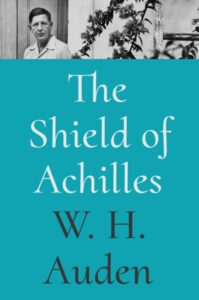W.H. Auden won the National Book Award in 1956 for his most cohesive collection to date
In 1948, poet W.H. Auden (1907-1973) received the Pulitzer Prize for Poetry for The Age of Anxiety, a long poem in six parts that addressed the search for identity and meaning in an industrialized world that was constantly changing. His poetry was already recognized as among the very best being published; the native-born Englishman and naturalized American occupied the top, or almost top, of the poetic literary world.
The poem reflects an event in Auden’s life that would become more pronounced as he grew older. He had embraced religious faith, and his poetry increasingly reflected that acceptance. But his poetry was also developing into a more cohesive entity, with poems informing and relating to each other in a directed and consistent way.
That cohesiveness (critics usually call it coherence) blossomed into full maturity with Auden’s 1955 collection The Shield of Achilles. It’s a remarkable work, not only for how the individual poems relate to each other but for Auden’s mastery of language that is often stunning.

W. H. Auden
As part of its Critical Editions series, Princeton University has republished The Shield of Achilles, edited by Baylor University professor and Auden scholar Alan Jacobs. Jacobs has previously published two Critical Editions on Auden, one on The Age of Anxiety and the other on For the Time Being: A Christmas Oratorio. Jacobs’ introduction to The Shield of Achilles is so good that one is tempted to review it as well as the collection itself. Instead, buy the book and get two gems for the price of one.
The collection is divided into three sections: “Bucolics,” “Sun and Shade,” and “Horae Canonicae,” or “Canonical Hours.” The first section concerns the natural world, with poems on winds, woods, mountains, lakes, islands, plains, and streams. It’s the world familiar to us all, and like his theme in The Age of Anxiety, the poems aren’t so much descriptions of nature as they are explorations of finding one’s self in the natural order.
The second section, “Sun and Shade,” contains the title poem. I was prepared for poems about the Trojan War, but that’s not precisely what Auden provides. He includes references to the war, to be sure, but we’re still considering our place in the world, and not only the world at war but the world in an uneasy post-war peace (the collection was published during the early years of the Cold War, roughly 1947 to 1991).
This poem depicts a familiar enough event in an Italian port city during the 1950s: navy sailors coming ashore after a voyage. Like the rest of us, and like the sailors and soldiers surrounding Troy in The Iliad, they, too, are looking to understand their place in the world, knowing that military service is temporary and subject to the whims of annual budgets.
Fleet Visit

Out of their hollow ships,
Mild-looking middle class boys
Who read the comic strips;
One baseball game is more
To them than fifty Troys.
They look a bit lost, set down
In this unamerican place
Where natives pass with laws
And futures of their own;
They are not here because
But only just-in-case.
The whore and the ne-er-do-well
Who pester them with junk
In their grubby ways at east
Are serving the Social Beast;
They neither make nor sell—
No wonder they get drunk.
But the ships on the dazzling blue
Of the harbor actually gain
From having nothing to do;
Without a human will
To tell them whom to kill
Their structures are humane
And, far from looking lost,
Look as if they were meant
To be pure abstract design
By some master of pattern and line,
Certainly worth every cent
Of the millions they must have cost.

Alan Jacobs
The collection’s third section contains seven poems bearing the names of the canonical hours — prime, terce, sext, nones, vespers, compline, and lauds. In a collection filled with beautiful poems, these are the most striking, suggesting that the physical, natural order is a function of the unseen, spiritual order. You travel through the day so familiar to religious orders, and Auden repeatedly connects that day to the familiar world known to all. In a way, he’s saying, “Don’t forget this; don’t overlook it or take it for granted. If you do, you may never find your place or your identity.”
Jacobs is the Distinguished Professor of Humanities in the Honors Program at Baylor University and a Senior Fellow of the Institute for the Advanced Studies of Culture at the University of Virginia. In addition to his Critical Editions book on Auden, he has also published Breaking Bread with the Dead, The Year of Our Lord 1943: Christian Humanism in the Age of Crisis, and How to Think. He also writes regularly for The Atlantic and The Hedgehog Review, and he blogs at The Homebound Symphony.
Auden is not the easiest poet to read, but he’s among the most rewarding. The Shield of Achilles is a masterwork in poetry. With its publication, Auden reached the height of his creative power. He had resolved his personal struggle with religious faith, and he had been bringing both the struggle and the resolution to his poetry. He found the coherence he’d been seeking, and that coherence reached full bloom with this work.
Related:
Poems (1930): The First Published Collection by W.H. Auden
Photo by waferboard, Creative Commons, via Flickr. Post by Glynn Young.
How to Read a Poem uses images like the mouse, the hive, the switch (from the Billy Collins poem)—to guide readers into new ways of understanding poems. Anthology included.
“I require all our incoming poetry students—in the MFA I direct—to buy and read this book.”
—Jeanetta Calhoun Mish
- Poets and Poems: Christina Cook and “Roaming the Labyrinth” - April 22, 2025
- Longfellow’s “Paul Revere’s Ride”: Creating a National Legend - April 17, 2025
- Poets and Poems: Katie Kalisz and “Flu Season” - April 15, 2025


Leave a Reply